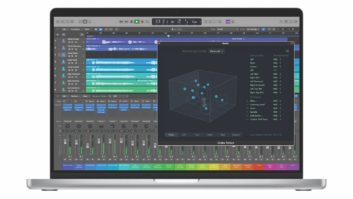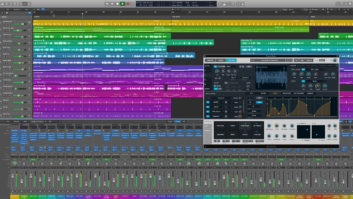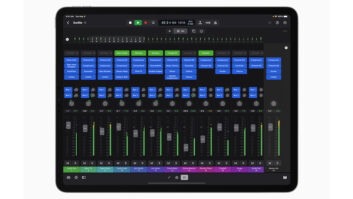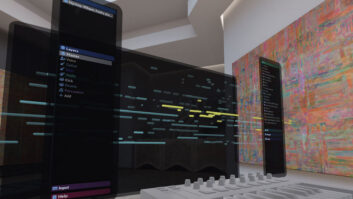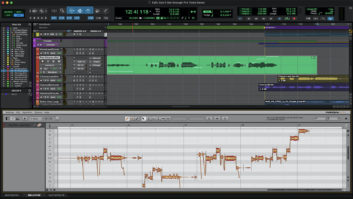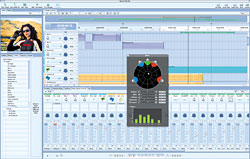
Clicking on a track’s surround pan icon brings up a surround panning puck with easy access to parameters.
Apple’s Soundtrack Pro 2 (SP2) workstation software for audio-for-video production has morphed into an entirely new program with each release. What began as a music-creation/looping tool later took on full DAW capabilities in its second version. Now in its third generation, SP2 has become an intensive application for serious sound-for-picture production. Previously only available as part of the $1,299 Final Cut Studio suite (which also includes Final Cut Pro 6 video editing, Motion 3 graphics/animation, color-picture correction, Compressor 3 release formatting and DVD Studio Pro 4 authoring), SP2 is now also offered as part of Apple’s new $499 Logic Studio bundle, making it available to a much larger audience of audio pros.
SP2 provides new multitrack editing and recording functions that speed the audio post process. In addition to a streamlined, single-window GUI, the revision’s additions include a versatile spotting display for aligning effects and dialog with picture, take-management tools for comping sections of several takes into a seamless performance, an auto-conform application for matching picture changes to audio, stereo and surround mixing (or both simultaneously), more included signal processing plug-ins — stereo and 5.1 — and more. Also in the package are some 5,000 pro-quality Foley and sound effects, and music tracks — 1,000 of which are in surround format. There are so many new features in SP2 (including a podcast producer) that space precludes detailing them all, but here are some highlights.
HORSEPOWER, PLEASE
Running SP2 (solo or with the Final Cut Studio) requires a decent Mac; minimum requirements include a 1.25GHz or faster G4, G5, Intel Core Duo or Intel Xeon processor with 1 GB of RAM, and Mac OS 10.4.9 or later. Obviously, the more RAM and processor speed, the better, especially when rendering long-form audio or HD video files in Final Cut Pro.
But the system did function on a dual 1.25GHz G4 with 1GB RAM. However, such cases may require the patience of a Zen master while waiting for most offline DSP actions (normalizing, time shifting, etc.). Performance was greatly improved on an Intel-driven MacBook Pro 17-inch laptop (2.4GHz/4GB RAM) and even better on a Mac Pro desktop with two 3GHz quad-core Intel Xeon 5300 Series CPUs and 8 GB of RAM. The cool part about the latter is its four 750GB internal drive bays for up to 3 TB of storage on quick-change drive caddies.
UPGRADE, UPGRADE
About a week after I got my Final Cut Studio/Soundtrack Pro 2 software, Apple released Version 6.0.1, with 175 MB of update files available at www.apple.com. These were mostly minor tweaks and bug fixes, but it’s a lot of downloading, not matter what your system. Fortunately, these are already implemented in the latest version. One of the updates was support for AVCHD-format HD cameras on Intel Macs. I first experienced crashes while doing this, but the problem was eventually traced to a conflict with the Perian QuickTime component. Once I deleted that file, HD transfers from my Panasonic HDC-SD1 worked fine. Hooray!
DIVE RIGHT IN
After I got the Final Cut Pro bundle, I was doing a video edit on a clip for Remix TV featuring an interview with the Chemical Brothers. Piece of cake, I figured. Edit 20 minutes down to about eight minutes, add titles and in/out bumpers, and I’m done. The band was great. The (offscreen) interviewer was great at asking questions, but wasn’t much of a videographer. Essentially, it was a static single-camera shoot (thankfully on a tripod) and the picture on the DV tape was black and white — probably from being in the wrong mode setting.
The audio was recorded about 30 dB down using an on-camera mic and the room was boomy with plenty of camera noise and the occasional sound of someone’s foot kicking the tripod. Importing the track from Final Cut Pro into SP2 is easy (one of the program’s great strengths), and once there I beheld this DAW’s new single-screen interface — clean and straightforward, all from one window without going through the confusion of having to open the track in a second window to make edits or DSP changes.
From here, I boosted the gain, which, along with the dialog, also brought up hiss and camera noise. I then addressed the tripod kicks — which showed up clearly in the new Spectrum view display of frequency vs. time, where amplitude is indicated via color intensity for unobtrusive edits. Next up was the camera motor noise, which yielded easily to the program’s Noise Print intelligent noise reduction, followed by some EQ — a high shelf to knock the hiss down and then some parametric to cut some of the room boom, adding intelligibility.
The tracks were imported back into Final Cut Pro, and the single-window interface is a nice touch, although it really needs a decent-sized monitor, which is hardly an issue these days. I was using two 23-inch Apple Cinema displays, which makes for a great package. Speaking of displays, one minor quibble I’ve had with both Final Cut Pro and Soundtrack Pro is the incredibly small (¼-inch tall) window that displays the locator times. With all the available real estate of large LCD or dual-panel monitoring, surely Apple could provide a preference option for a larger time display, like a big, red LED readout that’s visible from several feet away. My wish list also includes a large transport control window.
SLICK LITTLE TWEAKS
One of the coolest new features is a Multitake Editor, which lets you arrange multiple takes from an ADR or voice-over session, and use the solo buttons to audition each and highlight the preferred part. Individual parts can be edited and dragged/slipped for timing or sync tweaks and then highlighted, with crossfades applied to each to create a seamless composite.
I also liked using the Multipoint Spotting display, which lets you bring up three audio frames — like blowups from a timeline — to match audio placement points. Even in mundane situations, like dropping in car engine noise with a door-slam effect as a passenger enters, having the exact frame where the action start/occur/stops is a definite time-saver. In more complex scenes, this is a real plus.
SURROUND’S THE THING
The real highlight is the surround mixing capabilities, which were essentially nil and emerged as a pro environment. One update is the metadata-driven search tab, which provides quick access to the effects and music beds collection. The titles are marked to indicate whether they are stereo or surround. You can audition them with a mouse click and drag selections directly into the project.
Also included is the popular Space Designer plug-in taken from Logic Studio, which offers true surround processing. This real-time, 5.1 impulse-response convolution reverb is loaded with presets for emulating acoustical environments — real or imagined. Tweaking custom sounds was no sweat, and Space Designer’s reverberation effects — especially the sound of the smooth decay of reverb tails in surround — are first-rate. And this is just one of 55 stereo and surround plug-ins in the package.
The coolest part of surround mixing in SP2 is the surround panning puck that looks like an iPod (wonder where they got that idea?) and comes up with a double-click on the puck on any track in the main window. This provides a visual representation of the surround field, and offers 5-channel panning, surround metering display and control of image parameters: rotation, width, collapse, center bias and LFE. The best part here is how any adjustment of each slider dynamically alters the visual representation at the top of the puck.
AND IN THE END
With the release of SP2, Apple has addressed many of the audio community’s concerns and issues about bringing this program up to the standard that Final Cut Pro has achieved in the video world. As part of the Final Cut Studio bundle, SP2’s impact in the audio-only world was limited, but with Logic Studio should open some new eyes and ears to this now-serious contender.
Apple, 480/996-1010, www.apple.com/finalcutstudio/soundtrackpro.

